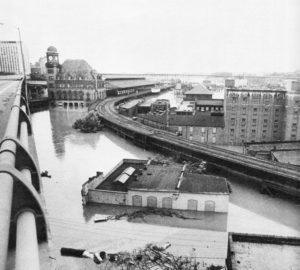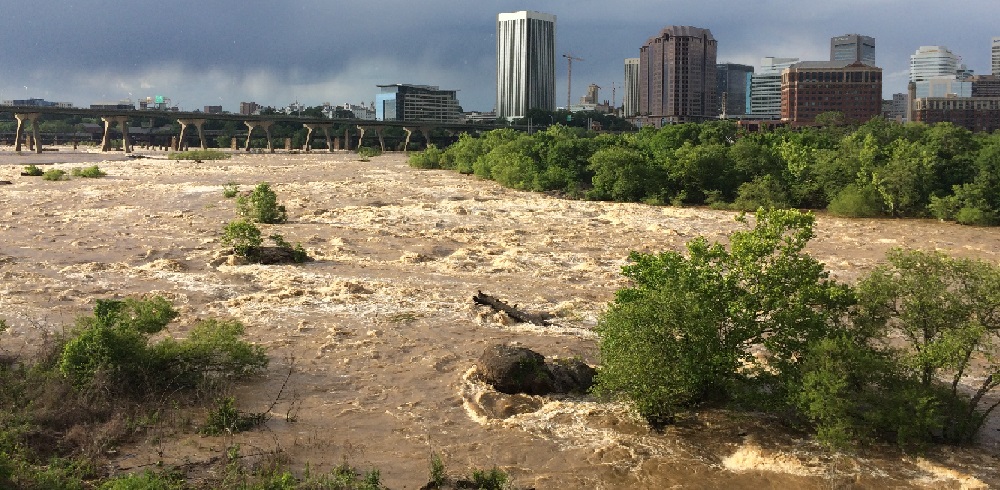The James River hit flood stage this week – 15.4 feet at USGS’s Westham gauge – but in comparison to Richmond’s flood-plagued past this round was rather run-of-the-mill. Still, as this last hurricane season showed us, floods are nothing to sneeze at. So what does it mean for residents of the River City when the James crests its banks? I’ll attempt to break that down in this post, and I’ve included some fun facts for those who make it to the end. Let’s dive in.

Main Street Station and Shockoe Bottom were inundated by Hurricane Agnes in 1972 – Richmond’s highest recorded flood. (Photo from http://vintagerva.blogspot.com).
First, consider this a PSA: unless you’re this guy and have completed this training, there’s really no reason to be in the water. Why? As NOAA and FEMA’s “Turn Around Don’t Drown” program is quick to remind us, all it takes is 6 inches of rapidly moving water to sweep someone off their feet, and the James is no stranger to the occasional swift water rescue.
It may seem intuitive to avoid swimming down Hollywood Rapids, but there’s a lesser-known reason to stay clear of the river above flood stage. Floods are quite a bit like Mother Nature flushing a toilet – an analogy that’s a lot more literal than many of us would like. Swollen rivers not only transport Virginia’s runoff downstream, but everything that runoff picks up along the way. This includes unsightly but generally harmless items like trash, as well as more subtle threats like fecal bacteria from livestock, pets, and even human waste.
If that comes as a shock, well, we don’t like it either, but to an extent it’s actually by design. Cities are required to capture and treat their stormwater (what comes from the sky) and wastewater (what comes from the toilet) before releasing cleaner, treated water back to the river. Wastewater volumes are pretty steady (we don’t all go at once, of course), but stormwater volumes can fluctuate enormously. For example, any Richmonder will tell you that it’s not unusual for several hot, dry weeks to be followed by a summer downpour that seems straight out of the tropics.
Now imagine you’re a city planner. If you have to treat both sources of water to the same standard, it would be easiest to do it at the same facility, right? Sounds great, and many cities do exactly that, until you have a heavy rainfall event that overwhelms that facility’s treatment capacity. What happens then? Unfortunately, the only option is to release the noxious mixture of drainage and sewage into the James – a phenomenon known as a Combined Sewer Overflow (CSO) event.
There are two important things to keep in mind. One – not all rainfall and flooding events are the same. Floods on rivers as large as the James usually stem from regional precipitation events – slow moving fronts, nor’easters, and hurricanes – rather than localized summer thunderstorms. However, localized downpours can sometimes be enough to overwhelm a sewer system (also local in scale, after all) while hardly budging the height of the river. Two – not all sewer systems are the same. Richmond (and many other old cities across the Northeast and Midwest) has a combined sewer system that mixes stormwater and wastewater for treatment, but many cities have newer, more sophisticated systems that separate these two sources of contamination. Richmond’s made great strides in improving the quality and capacity of its stormwater treatment plants (and deserves praise for its grassroots efforts), but as long as we remain on a combined sewer system, it will be impossible to completely prevent CSO events from occurring.
To conclude, a jump in the James is a cool, refreshing reprieve from Richmond’s summer swelter, and I’ve spent countless hours in the river, but it’s important to use discretion during high water or heavy rain. The James certainly isn’t as wild as the Nile or as dirty as the Ganges, but it’s a lot more like both at higher water. If you’re interested in keeping an eye on river conditions, check out products like the CSO alert notifications offered by Lynchburg and Richmond, or our own James River Watch.
That’s all for now, and thanks for reading! As promised, some fun flood facts are included below. Stay dry!
- The James’s flow peaked just above 70,000 cubic feet per second (cfs) on Monday evening February 12, 2018. According to some back-of-the-envelope calculations, that means the James could fill the entire volume of an empty Federal Reserve Building in less than two-and-a-half minutes.
- If Richmond were a flat, featureless frying pan, the James could cover its 62.5 square miles with a foot of water every 8 hours.
- From 6pm Sunday, February 11, 2018, to 6pm Wednesday, February 14, 2018, 97 billion gallons of water will have flowed down the James – enough in three days to cover the entire City of Richmond’s needs for the next 4 years!
- 97 billion gallons of water would fill 147,000 Olympic sized swimming pools.
- It would take Michael Phelps 42.5 days to swim this distance if he swam tirelessly at his 200m freestyle pace.

